Digital citizenship is a broad and ever-changing term. It describes the way in which we act on the internet, which is guided by a set of rules that describes an appropriate interactions and personal accountability (Wang & Xing, 2018). Digital citizenship also includes the way we work with new information that we find online (Wang & Xing, 2018). However, when these rules are not followed there can be a substantial impact.
It is important to teach digital citizenship because people worldwide are using the internet and social media more than ever.

Attribution: world location by ProSymbols from the Noun Project
https://thenounproject.com/term/world-location/564877/
One statistic that I found was that the average use of social media daily was 144 minutes (Clement, 2020). In order to ensure that our students are interacting with social media and the internet safely, we need to ensure that they have the proper education about acceptable uses, the impact of their internet presence. One interesting metaphor I found about the importance of digital citizenship was the “digital tattoo”. The digital tattoo describes the idea that what you put out on the internet is permanently painted onto your online identity, similar to a tattoo on your skin (University of British Columbia, n.d.). For students to be conscious of the information they put on the internet, we need to educate them about digital citizenship. Without this education, there is a greater chance for harm including cyberbullying, or sharing of personal information (Hsu et al 2019).
One way approach teaching digital citizenship in K-12 schools is through shaping students vision of what kind of behaviour, and decision making needs to go into interacting with information or posting information on the internet (Kim & Choi, 2018). I think that one way to do this would be through active modeling or speaking through a thought process. For example, teachers speaking through evaluating a source. Explaining the relationship between being a good person in the present and how that translates online (Kim & Choi, 2018). Overall, it should be an underlying theme or lesson that is incorporated into all work that students are doing on the internet. (Marrs, 2019)
I found a couple of interesting examples of actives that model digital citizenship that are practical to use in the classroom.
- Peer assessment of both handwritten and online work. In order to highlight the idea that we need to respect the person on the other side regardless of the medium. This can again be taken to the application towards social media (Farmer, 2011).
- Having a digital online portfolio and classroom blog (like what we have for the education program). Using the app Seesaw, Heather Marrs describes that she has students post an ongoing flow of their learning in blog post / social media post format. Which allows other students to comment and follow. This app also has a function to have students upload their work to make their own digital portfolio (Marrs, 2019). Furthermore, the teacher has to accept or decline what posts are allowed on the website, so no inappropriate comments go up. This app also allows for parents to easily follow their child’s learning by reading their posts and portfolio.
- Only cavate here is making sure that the app is FIPPA compliance and parent permission given
Overall, digital citizenship is an essential lesson that we need to be incorporating into our future classrooms in order to give the students the right skills so that they can be informed and hopefully make appropriate choices on the internet and to keep themselves safe. Within a school year this may start out as a class discussion and lesson but should be later incorporated into each online assignment that they do until it becomes second nature. We know, that if you don’t use it, you lose it and digital citizenship is a skill that is way to important to lose.
Clement, J. (2020, Feb 26). Daily Social Media Usage Worldwide 2012-2019. Retrieved from Statistica: https://www.statista.com/statistics/433871/daily-social-media-usage-worldwide/
Farmer, L. (2011). Directing the Digital Moral Compass: teaching Digital Citizenship. International Association of School Librarianship. The Annual Conference, (pp. 1-5). Bradford. Retrieved from https://search-proquest-com.prxy.lib.unbc.ca/docview/1221249403?pq-origsite=summon
Hsu, H. P., Wenting, Z., & Hughes, J. E. (2019). Developing Elementary Students’ Digital Literacy Through Augmented Reality Creation: Insights From a Longitudinal Analysis of Questionnaires, Interviews, and Projects. In Journal of Educational Computing Research (Vol. 57, Issue 6). https://doi.org/10.1177/0735633118794515
Kim, M., & Choi, D. (2018). Development of Youth Digital Citizenship Scale and Implication fot Educational Setting . Educational Technology & Society, 155-171.
Marrs, H. (2019, Oct 1). Don’t teach digital citizenship-embed it! Retrieved from ISTE: https://www.iste.org/explore/In-the-classroom/Don?articleid=809
University of British Columbia. (n.d.). What is the Digital Tattoo Project? Retrieved from University of British Columbia: https://digitaltattoo.ubc.ca/
Wang, X., & Xing, W. (2018). Exploring the Influence of Parental Involvement and Socioeconomic Status on Teen Digital Citizenship: A Path Modeling Approach. Educational Technology and Society, 186-199.

